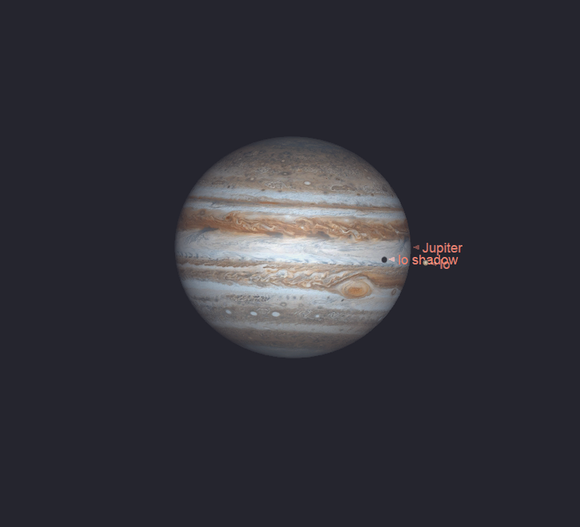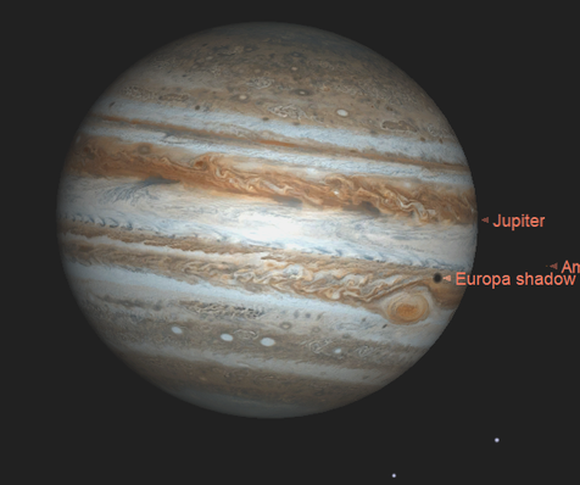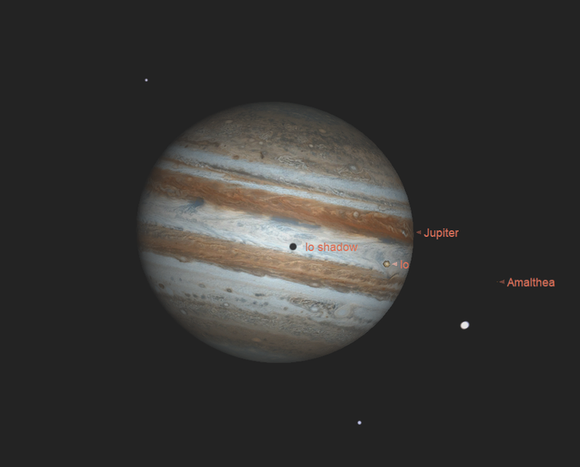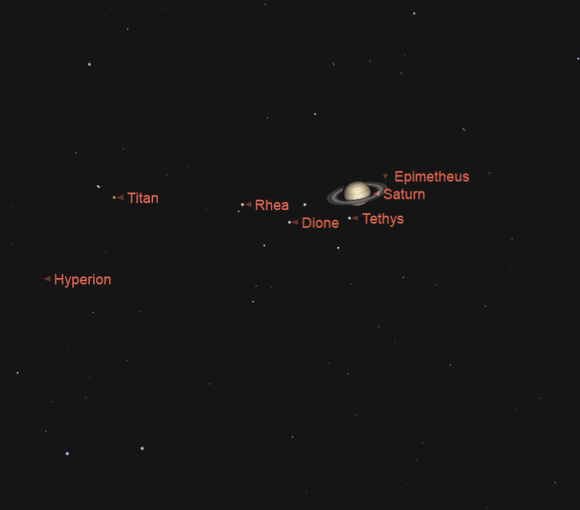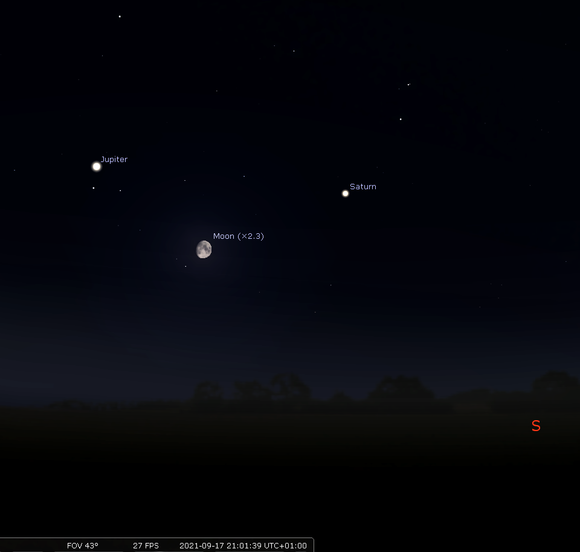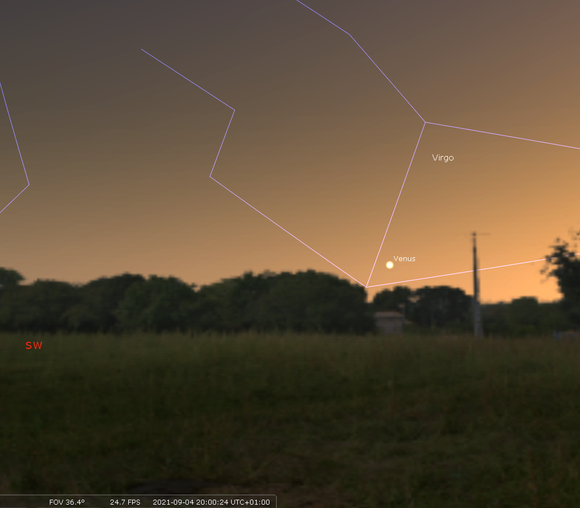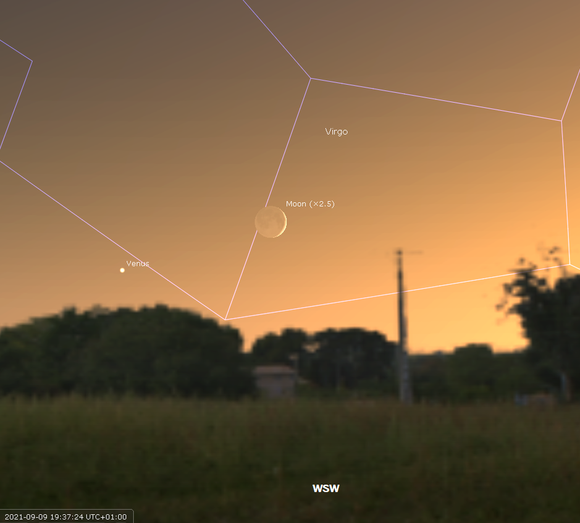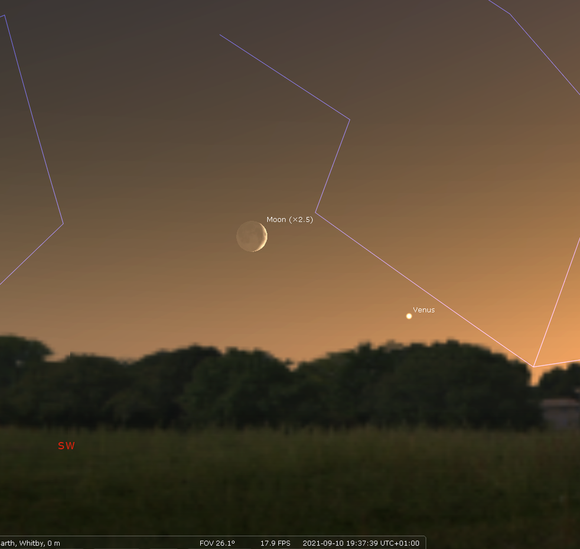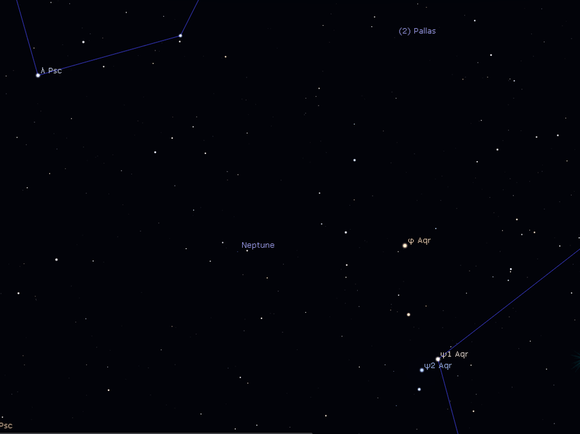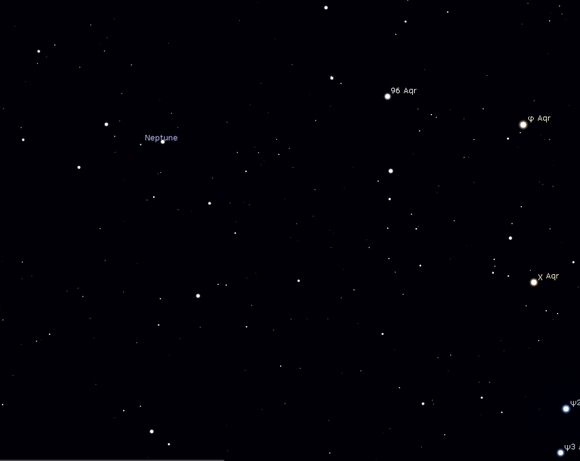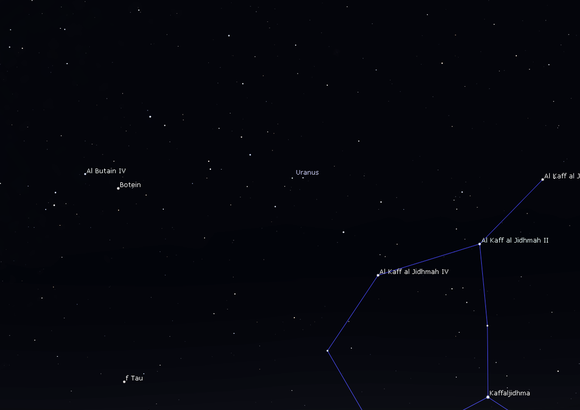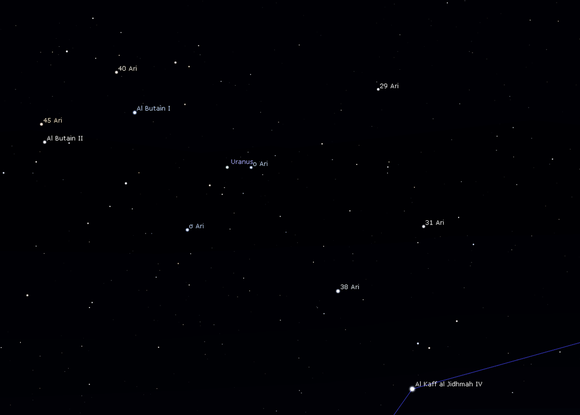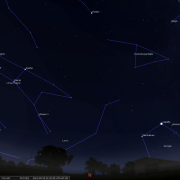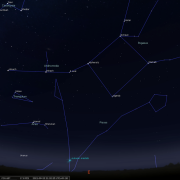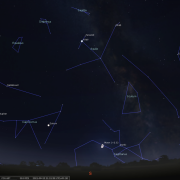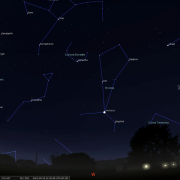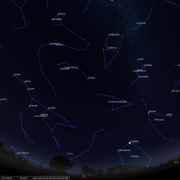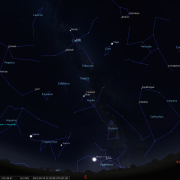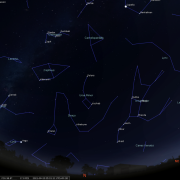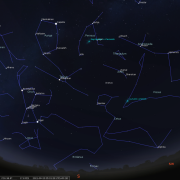In this month's Sky Notes:
Planetary Skylights - Brief
 Having reached opposition late last month, Jupiter will dominate September evenings low to the SE and S. At magnitude -2.7 its beacon like appearance can hardly be overlooked. Jupiter is also better placed for UK observers this year, culminating almost 9 degrees higher in the sky, the extra altitude equating to 'better seeing' and a longer observing window, especially as nights are lengthening once again. Jupiter resides on the Aquarius/Capricornus border and is in retrograde motion moving into Capricornus in September. At the start of the month Jupiter is visible by 20:00hrs and culminates sue south shortly before midnight around 23 degrees up. By the end of September Jupiter will be apparent by 18:45hrs, culminating around 22:15hrs. It will be a little higher the further south your location is in the UK.
Having reached opposition late last month, Jupiter will dominate September evenings low to the SE and S. At magnitude -2.7 its beacon like appearance can hardly be overlooked. Jupiter is also better placed for UK observers this year, culminating almost 9 degrees higher in the sky, the extra altitude equating to 'better seeing' and a longer observing window, especially as nights are lengthening once again. Jupiter resides on the Aquarius/Capricornus border and is in retrograde motion moving into Capricornus in September. At the start of the month Jupiter is visible by 20:00hrs and culminates sue south shortly before midnight around 23 degrees up. By the end of September Jupiter will be apparent by 18:45hrs, culminating around 22:15hrs. It will be a little higher the further south your location is in the UK.
Through the eyepiece Jupiter is a terrific sight, and many amateur astronomers consider it the most interesting planet to observe. During August the noticeably oblate disk will be a whopping 49 arc seconds in diameter, so there will be a good deal to observe. Even small telescopes will reveal the dark belts and bright zones, as well as the Galilean moons, adjacent to the disk. Scopes of 6" (150mm) or larger will reveal finer detail in the Jovian atmosphere including the Great Red Spot (GRS) feature, a vast storm which has been diminishing in size and colour intensity over recent years, but may now be re-establishing itself. It's certainly worth keeping tabs on from year to year, even month to month! The GRS can be seen on Jupiter at 21:30hrs or before midnight on the following dates; Sept 3, 6, 8, 11th 13th, 15th, 18th, 20th, 25th, and 30th.
Observers of the Jovian system will of course follow the 'dance' of the Galilean moons around Jupiter, throwing up a different configuration each night. The four major moons are visible in 10x50 binoculars as specks of light. Very small telescopes won't actually reveal much more, but 4" (100mm) aperture scopes and above, will show the cast shadow of a moon passing on the near side of Jupiter upon its disk. These 'shadow transits' are fascinating to follow, jet black dots of varying size. The actual moons themselves are more difficult to spot as they pass in front of Jupiter, requiring much larger apertures. The most favourable shadow transits this month are on the following dates and times. Io - 6th @ 21:45hrs & 21st @ midnight & 29th @ 21:00hrs. Europa - 6th @ 00:30hrs & 23rd @ 20:30hrs & 30th @ 21:30hrs. Callisto - 18th @ 00:30hrs.
 A month after coming to opposition Saturn is now be a prime observing target during the late evening and overnight. Residing amongst the stars in the west side of Capricornus, Saturn appears quite conspicuous with an apparent magnitude of +0.5 and has a pearly white lustre. Saturn will become visible at a similar time to Jupiter throughout September but culminates at a similar altitude to Jupiter an hour earlier, making it more convenient to observe from the UK. The magnificent ring system is still orientated well with respect to Earth, but are slowly closing up again, with the North Pole tilted toward Earth by almost 17 degrees. In the eyepiece Saturn remains a glorious sight, although the disk size of 18.5 arc seconds is less than half that of Jupiter's, but then again Saturn is twice as far away. When you factor in the rings however, the overall image compares more than favourably with Jupiter.
A month after coming to opposition Saturn is now be a prime observing target during the late evening and overnight. Residing amongst the stars in the west side of Capricornus, Saturn appears quite conspicuous with an apparent magnitude of +0.5 and has a pearly white lustre. Saturn will become visible at a similar time to Jupiter throughout September but culminates at a similar altitude to Jupiter an hour earlier, making it more convenient to observe from the UK. The magnificent ring system is still orientated well with respect to Earth, but are slowly closing up again, with the North Pole tilted toward Earth by almost 17 degrees. In the eyepiece Saturn remains a glorious sight, although the disk size of 18.5 arc seconds is less than half that of Jupiter's, but then again Saturn is twice as far away. When you factor in the rings however, the overall image compares more than favourably with Jupiter.
A scope with an aperture of 80-100mm (3.5-4") will reveal the two brightest rings; ring A (the outermost) and ring B. These are separated by the Cassini Division. Ring C lies closest to the disk but is difficult to spot, especially when Saturn is rather low. To fully observe this requires scopes of 150mm (6"). Saturn has at least 60 moons most of which are very small, but you should at least spot Titan, its largest moon as a speck nearby. Titan is bright enough (mag+8.4) to be spied in binoculars even. Titan takes just under 16 days to orbit round Saturn. Scopes of 200mm + (8") will also reveal Rhea, Tethys and Dione as well as Iapetus. The Moon lies between and below Saturn and Jupiter on the night of the 17th.
 Venus continues to 'flat line' just above the WSW horizon. At magnitude -3.7 Venus should be readily visible, but the low altitude and brighter sky conditions in this direction mean it's quite difficult to spot. Furthermore if you have horizon 'clutter' you probably won't spot it at all! View on the 9th at 19:40hrs when a very slender crescent moon lies approximately 4 degrees to the right of Venus and a day later, the same distance to the left. Observing approximaely 30 minutes after sunset each day throughout September, you will note that Venus remains almost at the same constant height above the horizon, but is gradually traversing back toward the SW. Given the low altitude, the image of Venus is naturally very poor in the eyepiece, even the phase is hard to distinguish; a 'fat quarter' at the start of the month and gibbous by the end.
Venus continues to 'flat line' just above the WSW horizon. At magnitude -3.7 Venus should be readily visible, but the low altitude and brighter sky conditions in this direction mean it's quite difficult to spot. Furthermore if you have horizon 'clutter' you probably won't spot it at all! View on the 9th at 19:40hrs when a very slender crescent moon lies approximately 4 degrees to the right of Venus and a day later, the same distance to the left. Observing approximaely 30 minutes after sunset each day throughout September, you will note that Venus remains almost at the same constant height above the horizon, but is gradually traversing back toward the SW. Given the low altitude, the image of Venus is naturally very poor in the eyepiece, even the phase is hard to distinguish; a 'fat quarter' at the start of the month and gibbous by the end.
 Neptune, the outermost planet, comes to opposition on September 14 this year and will be visible in the late evening sky low to the east - but you will require a telescope indentify it. Around opposition Neptune will 'closest' to Earth, but that is still approximately 2.7 billion miles (4.3 billion km) distant. It is located midway between the faint loop of stars in Pisces marking one fish and Aquarius, the nearest naked eye visible star being phi Aqr at +4.2 located a few degrees west of Neptune. At magnitude +7.7 Neptune will be visible in binoculars, but in reality a telescope of 100mm aperture is required to make out the ting blue/grey disk, which is less than 3 arc seconds across. See chart for location details.
Neptune, the outermost planet, comes to opposition on September 14 this year and will be visible in the late evening sky low to the east - but you will require a telescope indentify it. Around opposition Neptune will 'closest' to Earth, but that is still approximately 2.7 billion miles (4.3 billion km) distant. It is located midway between the faint loop of stars in Pisces marking one fish and Aquarius, the nearest naked eye visible star being phi Aqr at +4.2 located a few degrees west of Neptune. At magnitude +7.7 Neptune will be visible in binoculars, but in reality a telescope of 100mm aperture is required to make out the ting blue/grey disk, which is less than 3 arc seconds across. See chart for location details.
 Uranus has now made it into the late evening sky, visible low in the east by 21:00hrs. It is located in the southern reaches of Aries, but is closer to the head of Cetus than the crooked line of stars marking Aries itself. Uranus is slowly moving in the general direction of the Pleiades, passing below the lovely star cluster in 2025. At magnitude +5.7 it is brighter than Neptune and almost twice the angular diameter, but this is still very small. The nearest visible naked eye star is omicron Ari at magnitude. Technically speaking Uranus is actually visible to the naked eye. Transparent, very dark skies are required to achieve this, that and a working good knowledge of the background stellar field. Binoculars will help somewhat, but it still appears as a star like dot. Only with a telescope does the disk become less stellar looking in nature and more planetary which has a ghoulish grey/green lustre.
Uranus has now made it into the late evening sky, visible low in the east by 21:00hrs. It is located in the southern reaches of Aries, but is closer to the head of Cetus than the crooked line of stars marking Aries itself. Uranus is slowly moving in the general direction of the Pleiades, passing below the lovely star cluster in 2025. At magnitude +5.7 it is brighter than Neptune and almost twice the angular diameter, but this is still very small. The nearest visible naked eye star is omicron Ari at magnitude. Technically speaking Uranus is actually visible to the naked eye. Transparent, very dark skies are required to achieve this, that and a working good knowledge of the background stellar field. Binoculars will help somewhat, but it still appears as a star like dot. Only with a telescope does the disk become less stellar looking in nature and more planetary which has a ghoulish grey/green lustre.

So, did anyone spot any Perseids this year? Pre-midnight on Aug 12th was clear (i think) but cloud cover came over in the early morning hours (we believe). John McCue perhaps witnessed the most on the 13/14:-his report states ..."I saw eleven meteors on 13/14 August, nine of them Perseids, during the hour up to midnight. Three of them were really bright, and two of those left trains lasting a couple of seconds. The sky was perfectly clear, better than the night before, and the Milky Way was just visible. There will have been more after midnight when Perseus crept higher in the sky, and the observer was on the leading edge of earth's surface"
There are no major noteworthy meteor showers in September; however you may spot a few Piscids which have two peaks: the 8th and the 21st. Rates are low, with only 6 or 7 per hour at best, barely more than sporadic levels. As with all meteor showers early morning viewing will be best.
Autumnal Equinox 2021
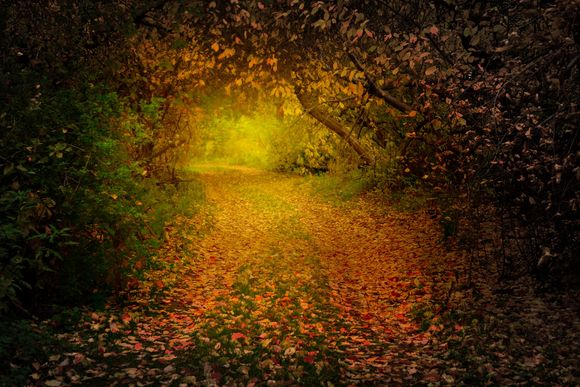
By astronomical convention autumn officially commences in the northern hemisphere on the date of the Autumnal Equinox, when from our perspective the Sun re-crosses the celestial equator and retreats southwards, arcing ever lower above the south horizon. This year the date of the equinox falls on September 22nd when, for a second time neither of Earths poles is inclined towards the Sun, but perpendicular to it. Again, hours of daylight and darkness will be almost equal across the globe. As the northern hemisphere continues to tilt away from the Sun, evenings will rapidly draw in once again as we head through autumn and into winter, until the Sun reaches the lowest position on the ecliptic - the winter solstice - around December 21st.
Additional Image Credits:
- Planets and Comets where not otherwise mentioned: NASA
- Sky Charts: Stellarium Software and Starry Night Pro Plus 8
- Log in to post comments

